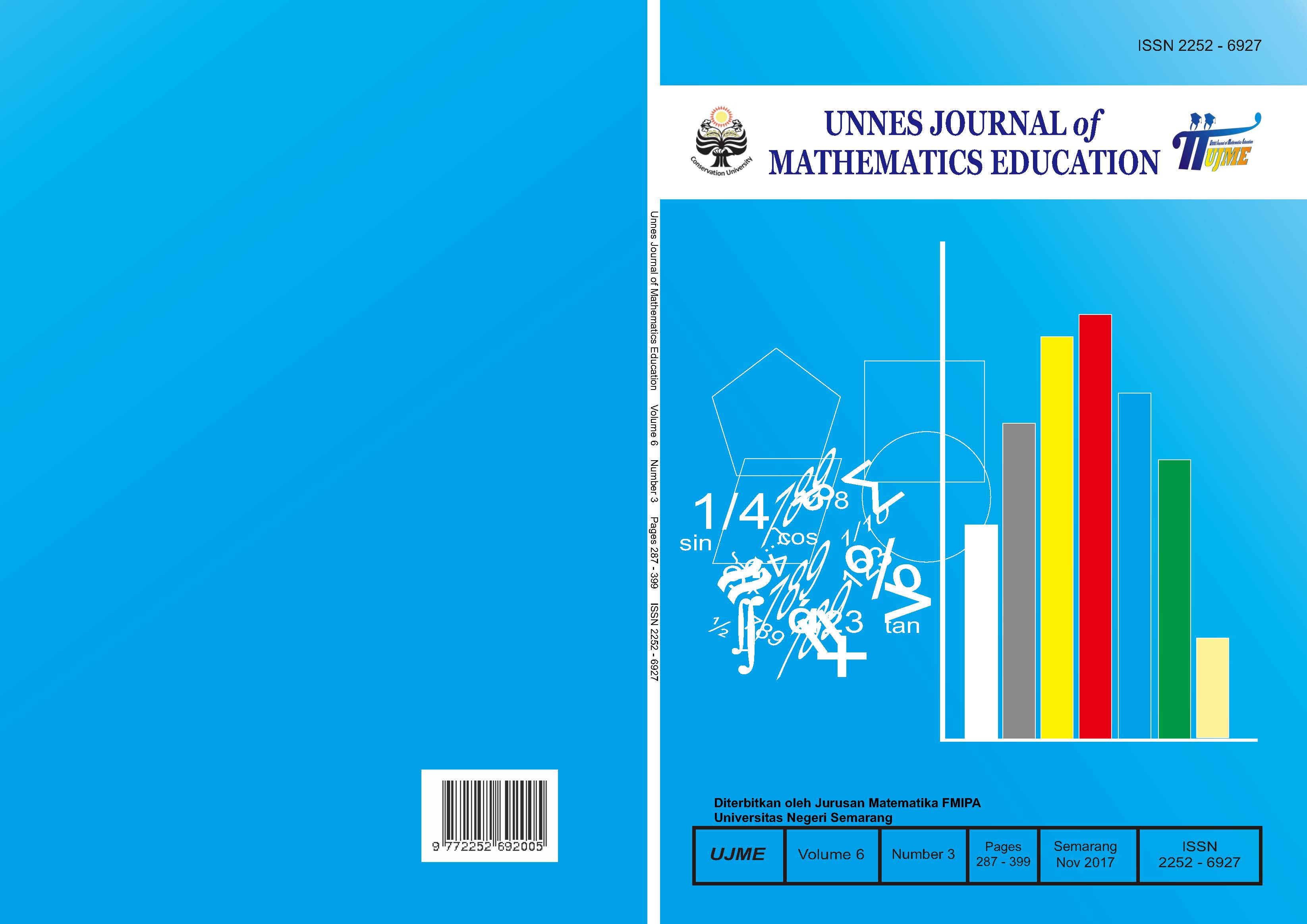The Analysis of Geometrical Reasoning Ability Viewed from Self-Efficacy on Connected Mathematic Project (CMP) Learning Etnomathematics-Based
##plugins.themes.academic_pro.article.main##
Abstract
The purpose of this research was to know the geometrical reasoning ability of the students viewed from the self-efficacy through the learning of Connected Mathematic Project (CMP) ethnomathematic-based. The type of this research was qualitative which was descriptive. To obtained the validity of the qualitative data, the checking technique used in this research was sources triangulation, which had been done by comparing the suitability of the obtained data from the results of the interview and the test. Population of this research was the students of grade VIII at SMP Negeri 1 Sidoharjo and the sample was the students from VIII A Class. At the final, 12 research subjects were chosen to represent the group of level 1 self-efficacy, level 2 self-efficacy, level 3 self-efficacy, level 4 self efficacy, level 5 self-efficacy, and level 6 self-efficacy. In this research, there was a finding which shows us that the students with high self-efficacy had low ability to finish the geometrical reasoning ability test, while the students with low self-efficacy had the ability to finish the geometrical reasoning ability test. The factors which affected the finding were the motivations and the interest of learning mathematics which was affecting the attitude of the students in the classroom.
##plugins.themes.academic_pro.article.details##
References
Clements, D. H. & Battista, M. T. (1992). Geometry and Spatial Reasoning. Dalam Grouws, D. A. (ED). Handbook of Research on Mathematics Teaching and Learning. MacMillan: Company, New York.
Csikszentmihalyi, M. (1975). Beyond Boredom and Anxiety. Amerika Serikat: Jossey-Bass Publishers.
Fitri, N., Hudiono, B., & Ahmad, D. (2013). Meningkatkan Kemampuan Penalaran Siswa Dengan Wawancara Klinis Pada Pemecahan Masalah Aritmetika Sosial Kelas VIII SMP. Jurnal Pendidikan Matematika FKIP UNTAN, I (1):6-7. Tersedia di http://download.portalgaruda.org/article.php?article=320530&val=2338&title=MEN [diakses 17 Juni 2017].
Glynn, S. M., Brickman, P., Armstrong, N., & Taasoobshirazi, G. (2011). Science Motivation Questionnaire II: Validation with Science Majors and Nonscience Majors. Journal of Research in Science Teaching, 48(10):1159-1176. Tersedia di http://onlinelibrary.wiley.com/wol1/doi/10.1002/tea.20442/full [diakses 09 Agustus 2017].
Hartoyo, A. (2012). Eksplorasi Etnomatematika pada Budaya Masyarakat Dayak Perbatasan Indonesia-Malaysia Kabupaten Sanggau Kalbar. Jurnal Penelitian Pendidikan, 13(1): 14-23. Tersedia di http://jurnal.upi.edu/file/3agung.pdf [diakses 02 Februari 2017].
Mukhid, A. (2009). Self-Efficacy. Jurnal Tadris, 4(1):107-108. Tersedia di http://ejournal.stainpamekasan.ac.id/index.php/tadris/article/view/247/238 [diakses 06 Juni 2017].
NCTM. (2000). Principles and Standart for School of Mathematics. United States of America: The National Council of Teachers of Mathematics.
Pajares, F & Urdan, T. (2006). Self-Efficacy Beliefs Of Adolescents. California: IAP.
Rohendi, D & Dulpaja, J. (2013). Connected Mathematics Project (CMP) Model Based on Presentation Media to the Mathematical Connection Ability Junior High School Student. Journal of Education and Practice, 4(4): 18-19. Tersedia di http://www.iiste.org/Journals/index.php/JEP/article/download/4512/4580 [diakses 01 Februari 2017].
Schunk, D. H. (1989). Self-Efficacy and Achievement Behaviors. Educational Psychology Review, I (3): 183-185. Tersedia di https://link.springer.com/article/10.1007/BF01320134 [diakses 19 Agustus 2017].
Shadiq, F. (2004). Penalaran, Pemecahan Masalah dan Komunikasi dalam Pembelajaran Matematika. Yogyakarta: PPPG Matematika.
Shin, S, Ki-Lee, J., & Ha, M. (2017). Influence of Career Motivation on Science Learning in Korean High-School Students. EURASIA Journal of Mathematics Science and Technology Education, 13(5): 1517-1538. Tersedia di http://www.iserjournals.com/journals/eurasia/download/10.12973/eurasia.2017.00683a. [diakses 01 Agustus 2017].
Silvia, P. J. (2003). Self-Efficacy and Interest: Experimental studies of optimal Incompetence. Journal of Vocational Behavior, 62 (2): 237-249. Tersedia di https://libres.uncg.edu/ir/uncg/f/P_Silvia_Self_2003.pdf [diakses 01 Agustus 2017].
Sirate, F. S. (2012). Implementasi Etnomatematika dalam Pembelajaran Matematika pada Jenjang Pendidikan Sekolah Dasar. Jurnal Lentera Pendidikan,. 15 (1):41-54. Tersedia di http://www.uinalauddin.ac.id/download04%20IMPLEMENTASI%20ETNOMATEMATIKA.pdf [diakses 02 Februari 2017].
Slavin, R. E. (1994). Educational Psychology, Theories and Practice. Fourth Edition. Masschusetts: Allyn and Bacon Publishers.
Sopyyev, Y. (2013). Implementasi Pembelajaran Think Pair Share pada Materi Fungsi Ditinjau dari Motivasi Belajar. Unnes Journal of Mathematic Education, 2 (2) :65-66. Tersedia di https://journal.unnes.ac.id/sju/index.php/ujme/article/download/3340/3081 [diakses 02 Agustus 2017].
Wahyuni, A, Tyas, A. A. W., & Sani, B. (2013). Peran Etnomatematika dalam Membangun Karakter Bangsa. Prosiding diseminarkan FMIPA, 12 September 2014.
Wardhani, S. (2010). Pembelajaran Kemampuan Pemecahan Masalah Matematika Di SMP. Yogyakarta: PPPPTK.
